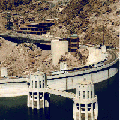


Hydropower has been used for millennia in most countries of the world. Its longest application has been for use in mechanical tasks, such as grinding grain. With such simple mechanical devices as a "noria", it has also long been used to lift water. Within the last 100 years, hydropower was applied to the conversion of its kinetic energy to electrical energy. Today, hydropower produces 24 percent of the world's electricity and supplies more than 1 billion people with power.
The obvious advantage of generating electricity in this manner is the very high (around 90%) conversion efficiency (compared to a typical conversion efficiency for a fossil fuel power plant of about 35%.) Additionally, there are no emissions to the atmosphere associated with this generation. The most controversial drawback is that the flooding produced behind the dams. canyons.
Well-known examples of hydroelectric facilities in Arizona include Hoover Dam (on the border with Nevada) and Glen Canyon Dam (near the border with Utah). Together these dams can generate about 3,000 MW of electrical power. The reservoirs that each dam creates (Lake Mead and Lake Powell) are heavily used for recreation. Other hydroelectric dams include those on the Salt River and the Colorado River below Hoover Dam. Several sites have been suggested over the years for additional large projects. These have been successfully resisted in all cases because they would infringe on scenic areas, such as Grand Canyon.
At least 22 sites have been identified in Arizona for pumped storage facilities, that is, ones that use off-peak power to pump water back behind dams, making the water again available for the generation of electricity during periods of peak demand. At least 37,000 MW of potential installed capacity has been identified for the state. To date, only a few have been built, all of which are associated with existing dams.
For more information on hydropower, a technology analysis is available from the National Renewable Energy Lab (NREL) web site.

